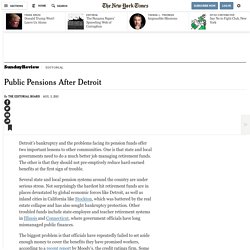

Detroit and Deindustrialization. This article is from Dollars & Sense: Real World Economics, available at This article is from the September/October 2013 issue of Dollars & Sense magazine.

Questions and Answers with Barry Bluestone By Barry Bluestone | September/October 2013 This July, the city of Detroit—half a century ago the jewel of U.S. industry and technology, and the unofficial capital of the U.S. labor movement—declared bankruptcy. Since its heyday in the 1950s, Detroit has seen the departure of most of the auto plants, first to surrounding suburbs, then further afield, and a downward spiral of the city’s economy. The factors involved in the city’s bankruptcy include multiple issues covered in the pages of Dollars & Sense in recent years.
Detroit’s Heyday: A One-Industry Town If you were to play word association, the reaction you would get to the word “Detroit” would change dramatically between the 1950s-1960s and the present. Packard Automotive Plant, East Grand Boulevard on Detroit’s east side, 2006. Detroit Outgrows Silicon Valley in Tech Jobs as Ford Hires. As a group of Ford Motor Co. managers in blue jeans sat down to interview a suit-wearing candidate from a California technology company this month, they jokingly offered to cut off his tie to put him at ease.
Auto industry executives are trying to make Silicon Valley engineers feel at home in Detroit. With a burgeoning number of technology job openings to fill, they’re scouring Internet companies for workers, wining and dining applicants, and seeking promising students at schools such as Stanford University. “We have a whole slew of job postings out there currently,” said Doug VanDagens, director of Ford’s connected service solutions, who has been trying to lure engineers to the automaker to design software.
“We’re just on a growth binge.” Expertise in cloud computing, mobile software applications and energy management are in demand in the Motor City as automakers replace car stereos with Internet radio and gasoline engines with motors powered by lithium-ion batteries. A new Detroit: Can the Motor City come back? ONE of this week's big American news stories was the release of new Census data for the state of Michigan, which revealed that the city of Detroit underwent a stunning population decline between 2000 and 2010.

Detroit shrank by 25% during the decade, and its population fell to its lowest level since 1910—before the era of Big Three dominance. The city seems to be locked in a death spiral. But could there be a light on the horizon? Bloomberg reports: Auto industry executives are trying to make Silicon Valley engineers feel at home in Detroit. Indeed, tech employment has been rising quickly in Detroit. Well, there are a few points to make. I think it's a little disconcerting that so much of the hiring seems to be driven by carmakers. This is one place where Detroit is at a significant disadvantage thanks to the condition of its broader economy. On the other hand, Detroit's ridiculously low costs are an advantage: Sure, Detroit salaries are 40% lower than Silicon Valley pay. Blue-Collar Hot Spots: The Cities Creating The Most High-Paying Working-Class Jobs. Motor City: The Story of Detroit. Public Pensions After Detroit. Detroit’s bankruptcy and the problems facing its pension funds offer two important lessons to other communities.

One is that state and local governments need to do a much better job managing retirement funds. The other is that they should not pre-emptively reduce hard-earned benefits at the first sign of trouble. Several state and local pension systems around the country are under serious stress. Not surprisingly the hardest hit retirement funds are in places devastated by global economic forces like Detroit, as well as inland cities in California like Stockton, which was battered by the real estate collapse and has also sought bankruptcy protection. Other troubled funds include state-employee and teacher retirement systems in Illinois and Connecticut, where government officials have long mismanaged public finances. Avoiding a Detroit-like downward spiral requires discipline and intelligence. Most government retirement systems are in much better shape than critics suggest.